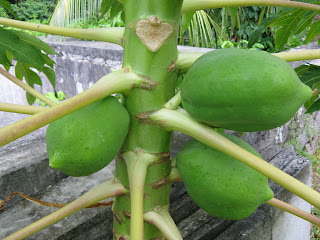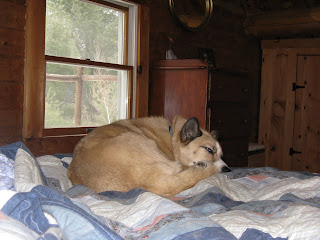
Low: 19° F
High: 41° F
Conditions: Sunny with winds 10-20 mph. 2 inches of new snow cover.
 A new marker for the Appalachian trail? A brand left by some enterprising pirate? Nope once again.
A new marker for the Appalachian trail? A brand left by some enterprising pirate? Nope once again.It’s a footprint. And not just any footprint, but one left by a wild turkey (Meleagris gallopavo). They're everywhere this time of year, and just yesterday we spied about ten of the actual birds in our back yard.

Yesterday was also the day for our annual town meeting, and at least one of us is delighted by the correlation. New England town meetings are a somewhat byzantine holdover from the colonial era, when townspeople took the notion of pure democracy very, very seriously. Our town is fairly new by New England standards (yesterday was only our 181st town meeting), but our annual gathering is no less staid in terms of policy and protocol. One Saturday each spring, the townspeople gather in our local Grange Hall to first discuss and then vote on every major article and initiative for the coming year. No issue is too small or mundane: from the $15 dog licensing fee to $100,000 to repair potholes, each expenditure and policy is debated and then brought to a vote. Usually these votes are simply done by voice, but if it’s close, we begin caucusing and divide into different groups scattered around the Grange Hall. Efficient? No. Messy? Always. I love it.
So what does this have to do with wild turkeys? You may recall that one of the biggest proponents of pure democracy, Ben Franklin, advocated for this strange, prehistoric-looking creature as our nation’s mascot. He's shown here, depicited with a suspicious band of cherub assistants.

"For my own part I wish the Bald Eagle had not been chosen the Representative of our Country. He is a Bird of bad moral Character. He does not get his Living honestly. You may have seen him perched on some dead Tree near the River, where, too lazy to fish for himself, he watches the Labour of the Fishing Hawk; and when that diligent Bird has at length taken a Fish, and is bearing it to his Nest for the Support of his Mate and young Ones, the Bald Eagle pursues him and takes it from him.Admittedly, Franklin had some pretty far-out ideas about U.S. mascots. He also suggested the rattlesnake, a rooster, a phoenix, and even the biblical figure of Moses. These, too, were overruled by other founding fathers.
"With all this Injustice, he is never in good Case but like those among Men who live by Sharping & Robbing he is generally poor and often very lousy. Besides he is a rank Coward: The little King Bird not bigger than a Sparrow attacks him boldly and drives him out of the District. He is therefore by no means a proper Emblem for the brave and honest Cincinnati of America who have driven all the King birds from our Country . . .
"I am on this account not displeased that the Figure is not known as a Bald Eagle, but looks more like a Turkey. For the Truth the Turkey is in Comparison a much more respectable Bird, and withal a true original Native of America . . . He is besides, though a little vain & silly, a Bird of Courage, and would not hesitate to attack a Grenadier of the British Guards who should presume to invade his Farm Yard with a red Coat on."
As for his take on the turkey? Based on Ari's interest, I think she'd endorse his choice. But I’m not so sure I agree with them.
Wild turkeys are polygynous, which means the males take more than one mate at a time. This time of year, each male in our area is creating his own little harem. Once he is done mating, he will take no part in raising the brood, nor will he help with the female’s aggressive protection of the chicks against fox, hawks, or even Franklin's maligned eagles, all of whom become willing predators of turkey chicks (which are actually called poults). Males create fierce hierarchies within any flock, and the alpha-bird will go out of his way to make sure the other males don’t get a chance to flirt (let alone mate) with any of the females.
As for the ladies, I think they might be of questionable moral character as well. Most noticeably, they’re known to “dump” their eggs in the nest of some other unsuspecting female, presumably so that they don’t have to be troubled by maternity. If she can’t find another female turkey, a new mom will think nothing of dumping her eggs in the nest of a ruffed grouse or a ring-necked pheasant so that she can enjoy spring unencumbered. Talk about an ugly duckling story.
So, what say you, dear readers? Are Ben Franklin and Ari right? Is the wild turkey really the perfect emblem for America? We're looking forward to hearing your thoughts.


 I’ve taken the caninaturalist to see some sap-leeching trees and logs. She wasn’t very impressed. And the aluminum sap buckets aren’t very interesting to her either. But the boiling process is. We recently helped our neighbor convert her sap into syrup. It takes 10 gallons of sap to produce one quart of syrup. That’s a lot of boiling—sometimes even two straight days of cooking off the excess moisture. As the sap cooks, wonderful caramelized smells start wafting off the boiler. That’s when Ari gets interested.
I’ve taken the caninaturalist to see some sap-leeching trees and logs. She wasn’t very impressed. And the aluminum sap buckets aren’t very interesting to her either. But the boiling process is. We recently helped our neighbor convert her sap into syrup. It takes 10 gallons of sap to produce one quart of syrup. That’s a lot of boiling—sometimes even two straight days of cooking off the excess moisture. As the sap cooks, wonderful caramelized smells start wafting off the boiler. That’s when Ari gets interested.

 First, let us congratulate you for your meteorological prowess. Without radar, satellite imagery, or fancy maps of the U.S., you correctly surmised that New England would remain in a deep freeze. Well done.
First, let us congratulate you for your meteorological prowess. Without radar, satellite imagery, or fancy maps of the U.S., you correctly surmised that New England would remain in a deep freeze. Well done.















 As many of you know, fox scat is Ari’s very favorite thing. I find it disgusting. She once contracted a nasty parasite getting too intimate with a particularly rank sample. But she doesn’t care about either of these facts. As far as Ari is concerned, fox scat is the most perfect substance on the face of the planet. She lives to eat it and, on the very rare occasion when she’s too full, rolling in the scat offers an acceptable consolation prize for the caninaturalist.
As many of you know, fox scat is Ari’s very favorite thing. I find it disgusting. She once contracted a nasty parasite getting too intimate with a particularly rank sample. But she doesn’t care about either of these facts. As far as Ari is concerned, fox scat is the most perfect substance on the face of the planet. She lives to eat it and, on the very rare occasion when she’s too full, rolling in the scat offers an acceptable consolation prize for the caninaturalist. That’s when something clicked. Red squirrels: Ari’s second biggest obsession. When she’s not scolding them for raiding our birdfeeders, Ari spends most of her time trying to catch them. Maybe that’s part of the appeal of the fox scat: even recycled, it still resembles squirrel. Fox + Squirrel = Heaven for Ari, regardless of the form.
That’s when something clicked. Red squirrels: Ari’s second biggest obsession. When she’s not scolding them for raiding our birdfeeders, Ari spends most of her time trying to catch them. Maybe that’s part of the appeal of the fox scat: even recycled, it still resembles squirrel. Fox + Squirrel = Heaven for Ari, regardless of the form. 
 Smaller than my fist, this nest impressed us both in its artistry and its diminutive size. In fact, we might has missed it altogether if the caninaturalist hadn’t spied the first robin (
Smaller than my fist, this nest impressed us both in its artistry and its diminutive size. In fact, we might has missed it altogether if the caninaturalist hadn’t spied the first robin (







 . . .Others in canvas tote bags:
. . .Others in canvas tote bags: But most just sauntered in with their humans. And when they did, they found a dozen different tables featuring information on the dog park, displays by local book stores, and more. Dogs could sit for a portrait artist. . .
But most just sauntered in with their humans. And when they did, they found a dozen different tables featuring information on the dog park, displays by local book stores, and more. Dogs could sit for a portrait artist. . . . . . Or they could relax with a deep tissue massage.
. . . Or they could relax with a deep tissue massage. Our personal favorite booth was the interactive "Jackson Paw-Lick" Art Station, where dogs could demonstrate their own aesthetic. Here's a picture of me displaying Ari's masterpiece, which will be up for auction later this spring.
Our personal favorite booth was the interactive "Jackson Paw-Lick" Art Station, where dogs could demonstrate their own aesthetic. Here's a picture of me displaying Ari's masterpiece, which will be up for auction later this spring. 
 . . . And gear available for swap.
. . . And gear available for swap.  A local celebrity, "Pooper Man", even made a guest appearance in an effort to raise awareness about the importance of cleaning up after your dog. Based on her expression, can you guess how the caninaturalist feels about public service announcements?
A local celebrity, "Pooper Man", even made a guest appearance in an effort to raise awareness about the importance of cleaning up after your dog. Based on her expression, can you guess how the caninaturalist feels about public service announcements? Even still, a great time was had by all. We watched the creation of new friendships . . .
Even still, a great time was had by all. We watched the creation of new friendships . . . . . . And some controlled mayhem, too.
. . . And some controlled mayhem, too. Overall, the Jamboree was a wonderful success and raised about $8000 for construction costs. That's enough to begin excavation for the fence work as soon as the ground begins to thaw. We can’t wait to try out the new park this summer!
Overall, the Jamboree was a wonderful success and raised about $8000 for construction costs. That's enough to begin excavation for the fence work as soon as the ground begins to thaw. We can’t wait to try out the new park this summer! 
















